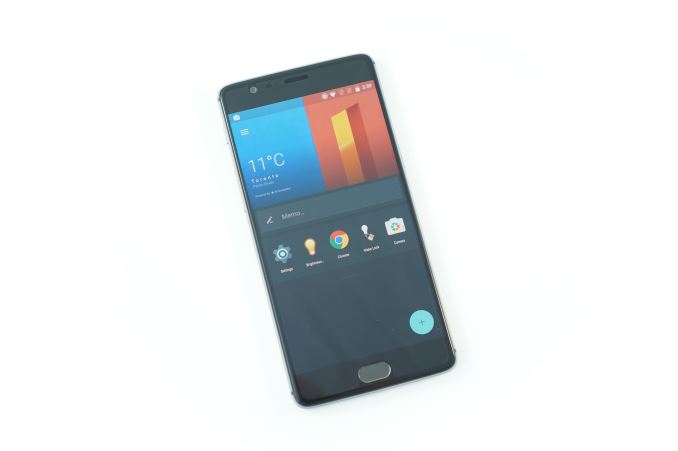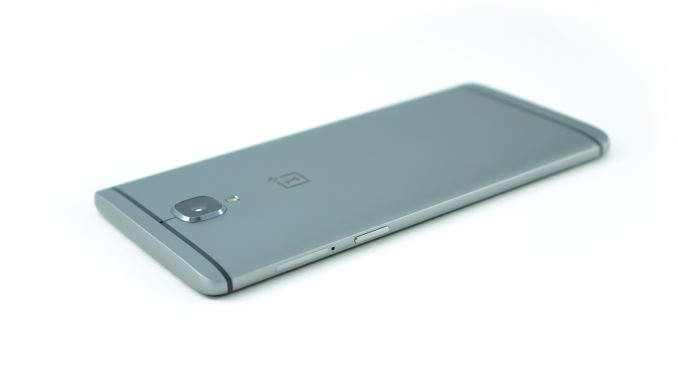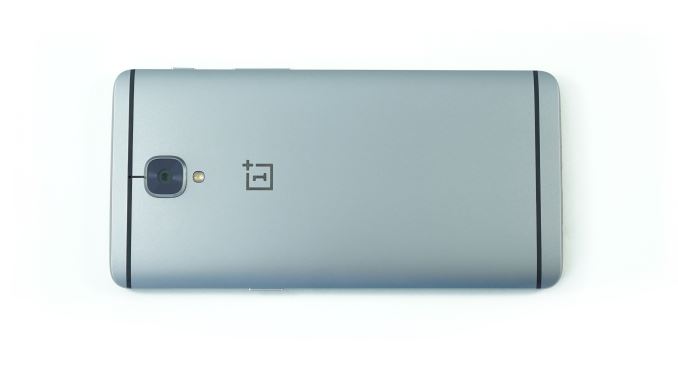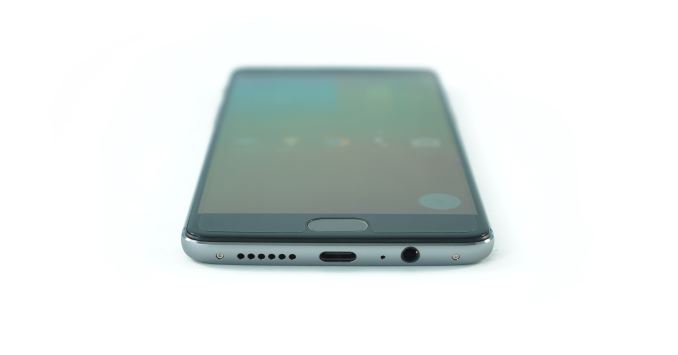The OnePlus 3 Review
by Brandon Chester on June 20, 2016 8:00 AM EST- Posted in
- Smartphones
- OnePlus
- OnePlus 3

In 2014 OnePlus was a company that was basically unheard of. Despite that, there was great anticipation in the Android enthusiast community about a new smartphone coming from this new company. Their first smartphone ended up being called the OnePlus One, and it was arguably the first device in a trend of smartphones that tried to bring flagship specifications to devices with prices much lower than what the big players in the smartphone market demanded for their best smartphones. The OnePlus One certainly wasn't perfect, but it showed that it was possible to produce a high spec smartphone for hundreds of dollars less than Android flagships, and what OnePlus needed to improve on was their execution.
A year came and went, and OnePlus came out with the OnePlus 2. This was during a time where the Android market was still struggling to deal with the issues posed by Qualcomm's Snapdragon 808 and 810 SoCs, which put Android performance improvements at something of a standstill. In the case of the OnePlus 2, I discovered that OnePlus had put mechanisms in place that reduced web performance even further, and as I reviewed the OnePlus 2 I discovered concerning regressions in other aspects like the phone's display, and its battery life.
Moving into 2016, we now have the OnePlus 3. At this point OnePlus now has a better variety of hardware to choose from, and they should know exactly what to fix from the OnePlus 2 to make a great smartphone. However, the smartphone market gets more competitive with each year that passes, and it's no longer enough to simply put good specs in a device and fail with the execution. Finding out how well OnePlus executed with the user experience is what I'm here to tell you, but before getting in to that, it's important to see how the OnePlus 3 compares to its predecessor.
| OnePlus 2 | OnePlus 3 | |
| SoC | Qualcomm Snapdragon 810 | Qualcomm Snapdragon 820 |
| GPU | Adreno 430 | Adreno 530 |
| RAM | 2/4GB LPDDR4 | 6GB LPDDR4 |
| Display | 5.5" 1920 x 1080 IPS LCD | 5.5" 1920 x 1080 PenTile AMOLED |
| Size / Mass | 151.8 x 74.9 x 9.85mm, 175g | 152.7 x 74.7 x 7.35mm, 158g |
| Battery | 3300 mAh | 3000 mAh |
| Rear Camera | 13MP 1.3 μm OmniVision OV13860 f/2.0 | 16MP 1.1 μm Sony IMX298, f/2.0, OIS |
| Front Camera | 5MP 1.4 μm OmniVision OV5648, f/2.0 | 8MP 1.4 μm Sony IMX179, f/2.0 |
| Storage | 16/64GB eMMC | 64GB UFS 2.0 |
| I/O | USB 2.0 Type-C connector, 3.5mm audio | |
| Connectivity | 802.11a/b/g/n/ac + BT 4.1 USB-C, GPS/GNSS |
802.11a/b/g/n/ac + BT 4.2, USB-C NFC, GPS/GNSS |
| Price | $329 (3GB/16GB) $389 (4GB/64GB) |
$399 (6GB/64GB) |
At least at a high level, the OnePlus 3 shows a great deal of promise. The move from Snapdragon 810 to 820 will certainly improve performance, especially when you consider the app detection that OnePlus was doing which crippled web performance on the OnePlus 2. There's also a whopping 6GB of RAM. I do wonder if 6GB is overkill only because the number of apps that people actually use on a daily basis may be smaller than the number that 6GB can actually keep resident in memory. It's also worth noting that there is an energy cost to adding more RAM as each memory cell has to be periodically refreshed to maintain data integrity.
OnePlus has moved to an AMOLED display with the OnePlus 3. While it was once the case that AMOLED displays that weren't on Samsung devices exhibited low brightness and poor calibration, recent AMOLED devices have reversed that trend entirely. However, moving from a 1080p RGB LCD to a 1080p PenTile AMOLED does come with a reduction in effective resolution, and I'll talk about that more in the display section.
With the cameras, OnePlus has gone back to Sony sensors. The front-facing camera moves to 8MP, and the rear-facing goes to 16MP. Lenses stay at f/2.0 which I think is a smart move given some of the problems we've seen regarding sharpness and distortion on phones that have moved to even wider apertures. There's more to the camera story than what you see on paper, and I'll be covering that as well.
As for other changes, there's now only one version of the phone which is 6GB of RAM and 64GB of UFS 2.0 storage for $399. I almost never saw the 16GB OnePlus 2 for sale anyway, so this isn't really some sort of pricing upset. As for connectivity, you still have a USB 2.0 based Type-C connector and 802.11ac WiFi, but NFC has made a return which means the OnePlus 3 will be usable with Android Pay and other applications that make use of NFC.
Design
One of the big changes OnePlus has made with the OnePlus 3 is the industrial design. Nothing about the OnePlus One's design was really exceptional, but given that it was bringing many flagship specs to a phone that costed several hundred dollars less than flagship phones of the time it was entirely understandable. With the OnePlus 2 the average price of OnePlus's flagship phone went up, but OnePlus had made some changes to the external design. The phone gained a metal frame but retained its sandstone back cover. To be honest, I wasn't really a fan of the OnePlus 2's design. The metal frame didn't do much to improve how high quality the phone felt, and the back cover wasn't coarse enough to really have an impact on how grippy the chassis was. On top of that, the fact that the display layer of the phone had a plastic border that sat above the metal frame looked kind of cheap, and the increased thickness and mass actually represented regressions from the OnePlus One in some respects.
With the OnePlus 3, OnePlus has moved to an aluminum unibody design. In doing so they've addressed pretty much all of my issues with the OnePlus 2. Starting with the back of the device, you no longer have the sandstone finish. I'm sure many people will disagree, but the OnePlus 2 back cover didn't help me with gripping the phone at all. The OnePlus 3 feels like a much higher quality device, particularly because there are no longer three distinct sections of the phone that all have seams and gaps between one another. The unibody design means the back cover is no longer removable, but as I said in my OnePlus 2 review I think the removable back cover on OnePlus devices was a complete waste anyway because it only served as a way to access the SIM slots, which could have been implemented as a tray on the side of the device. With the OnePlus 3 they've done exactly that, and so the removable back cover isn't needed.
The back cover sees some additional changes, with some being independent of the move to an aluminum chassis. There are now lines for the antennas on the top and bottom of the phone, and the top line connects to the square-shaped camera sitting beneath it, which reminds me of the HTC One M9. On the topic of the camera, there's no longer a separate island that the camera and flash sit upon, which I think is a big improvement on what I felt was one of the least appealing visual aspects of the previous OnePlus devices. The camera does stick out significantly more than it did on the OnePlus 2 which is just a consequence of the significant reduction in thickness, and OnePlus has actually decreased sensor size with this generation so the hump likely would have been even larger if they hadn't. The only other thing to note about the camera area is that there's now just a single LED flash and the camera uses PDAF, while the OnePlus 2 had a dual LED module and an IR module for the laser autofocus.
On the left side of the phone you have the volume rocker and the mute switch, while the right side has the sleep/wake button and the NanoSIM slots. I appreciate that OnePlus has kept their volume rocker on the left side of the phone, and I think the three stage mute switch is an underappreciated feature that more manufacturers should adopt. You can see above that the phone's edges only curve to a point, at which point you have a chamfered edge that meets the display glass. I like the appearance that this provides, but it does mean that you don't have the same smooth feeling when swiping near the edges of the display that you get on a device like the iPhone 6s Plus.
The bottom of the phone is changed from the OnePlus 2. There are no longer any antenna lines since they wrap around the left and right sides of the phone, and there aren't holes drilled on both sides of the USB Type-C port which has allowed the 3.5mm audio jack to be brought to the bottom of the phone. One thing that bothers me is how the 3.5mm jack isn't centered like the rest of the ports and screws, which kind of ruins the visual uniformity. You can also see OnePlus's pre-applied screen protector in the image above. It doesn't quite cover the entire display from edge to edge, and I noticed that a great deal of dust was collecting around the edges so I ended up removing it. It's just your typical plastic screen protector rather than a glass one anyway, although the fact that OnePlus throws it in for free is a nice gesture.
The front of the phone is similar to the OnePlus 2, but it's clear how the overall shape of the phone has changed to become more curved, while the OnePlus 2 was similar to the Nexus 5 in how it had flat sides meeting curved ones at hard angles. I have to say that I prefer the appearance of the OnePlus 3 in this regard, but it may be seen as less unique than the OnePlus 2. As for what's on the front cover, you have the earpiece and front-facing camera on the top, with three capacitive keys on the bottom. The middle key is the home button, which also acts as a fingerprint scanner in the same manner as the OnePlus 2's home key. In my experience the sensor has been quite accurate and just as quick as anything else on the market, and having it on the front of the device provides a better experience than rear-mounted scanners.
OxygenOS provides many ways to customize the phone, so you also have the option to switch the order of the back and recent apps buttons, and if you want software keys OnePlus provides that as an option as well. I covered the major points of OxygenOS in my OnePlus 2 review, and I haven't seen any major changes to it so I'll just refer to that rather than going over the features a second time. The one thing that has changed is that the UI no longer feels unbearably slow and sluggish, and in the next section you'll see exactly why that is.













176 Comments
View All Comments
thek - Monday, June 20, 2016 - link
Regarding the last line - what I mean is that even if those companies flagships have slight bumps they should still be highly recommended for the sake of maybe making other big companies charge less for their phones (which they obv can do if this one costs 400$), or provide more for that same amount of money. They don't innovate because we just don't give them enough hard time for providing the same phone every year but with just more gimmicks, and not practical things like battery sizes and storage10basetom - Monday, June 20, 2016 - link
If they really want to help consumers save money, they should've gone with 3GB of RAM and keep the same $349 price tag. That extra 3GB is mostly for show at the moment (except maybe when you're playing 3D games).thek - Monday, June 20, 2016 - link
again, going for the one that tried to do something good.why not take the argument to apple for having only 2GB (or 1!!!!!) up until a year ago or to Samsung (and of course, Apple again) for keeping the batteries at a pathetic 2000-3000~ mark when they can provide much more if they wanted?
''why 6'' is a worse argument than ''why only 2''.
LukaP - Monday, June 20, 2016 - link
(speaking about ram now)Because, in case you havent noticed, the iPhones up until last year, didnt need more than a gig of ram, and still perform great with 2gigs, so why increase BOM and power usage for silly specs?
As for the batteries, these are very much parts that are dependent on the design of a phone. Sure they could slap in a 6000mAh battery into the next Galaxy, but then people like you, if not you, would be complaining here taht the phone is heavy and feels like a brick.
I personally dont have a problem with smaller batteries/ram amounts/resolutions if it doesnt compromise the user experience. and speaking from a perspective of an iPhone SE owner, the lower resolution screen is not noticable, the low battery capacity provides me more usable time than any Galaxy S device ive had before, and multitasking is faster and much less disruptive than it has ever been, despite "only" 2 gigs of RAM.
So why bash them for stupid "features"? Because either they could not include them, and save money, or not include them, adn spend that money on something that really matters, like a better screen, or atleast in factory calibration of what they have now.
UtilityMax - Monday, June 20, 2016 - link
The claim that iPhones like the 6, didn't need more than 1GB, even last year, is just BS. I had iphones with 1GB of RAM, and the apps and the tabs inside the web browsers kept reloading without any warning, sometimes losing data all the time. Yes, Apple did clever things to make sure the phone doesn't literally run out of memory, but multitasking was horrible. Moreover, It's truly ridiculous that a former flagship phone like iPhone 6 is no longer future proof, even though it's only two years old.Buk Lau - Monday, June 20, 2016 - link
there's a difference between "having 6GB of RAM" and "having 6GB but only limiting usage to something lower." what oneplus is doing is simply limiting RAM usage on the kernel level to something lower than 6; if that's the case, why have 6GB of RAM at all? what's the point if I pay for 6GB but can't use all of it at my will? oneplus said they are doing to save battery, but if that's the case why not just take off 2GB and use that money for a bigger battery? "why 6" isn't the argument here, it's "why 6 when only use 4?"melgross - Monday, June 20, 2016 - link
Because iOS functions differently. Android keeps apps open, and running, when you aren't using them, when they don't need to, absorbing RAM, processor cycles and battery power. Except for apps that need to do work in the background, iOS doesn't keep them open. Sometimes I have 50 apps in the que, but they're not actually open. The state of the apps are kept, and when we go to them again, it seems as though they were open.This is why iOS needs less RAM than Android.
UtilityMax - Wednesday, June 22, 2016 - link
But iOS keeps killing the apps and reloading the web browser tabs so aggressively that it really affects the usability. The 1GB iPhones are getting pretty much useless to me right now, because all they spend most of their time on, seemingly, is to reload the web browser tabs, silently, sometimes losing my data. I never run into such issues with the Android phones with 2GB of memory. What iOS did was simply a hack to hide the facts that iPhone 6 shipped with an inadequate amount of RAM.UtilityMax - Wednesday, June 22, 2016 - link
2-3GB of RAM is more than adequate. But 6GB is pretty much ridiculous. Ask any power-user or any price conscious user, and they would probably tell you that they would gladly trade the 3GB of Oneplus 3's RAM for better screen or an sd card slot or more battery life. 6GB is pretty much superflous at this point.LiverpoolFC5903 - Tuesday, June 21, 2016 - link
RAM is cheap though, as you can see by the glut of sub 300 USD phones from China with 3/4 GB RAM and weak processors. Even phones with a processor as weak as the Mt 6753 have 3GB at least these days. That extra 3 gb should no have added all that much to the bom, especially compared to the SOC and Display.Companies who gimp on RAM do it because they want to create sub segments and not because it adds a lot to the bom.
In any case, 2GB is more than sufficient for anything in Android, anything above is a waste. I dont need 100 apps in memory, no thanks. 6 GB is ridiculous overkill imho.